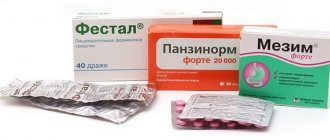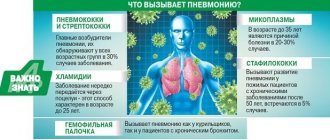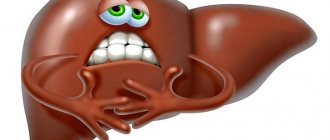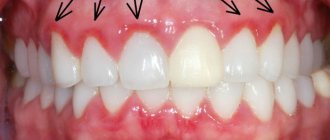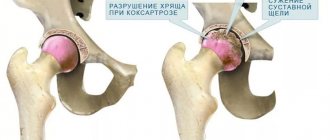Complications of influenza
The influenza virus disrupts the protective functions of the mucous membrane of the respiratory system, so influenza can provoke the development of complications such as pneumonia, bronchitis, complications from the ENT organs (sinusitis, tonsillitis, otitis), allergies, and in very severe cases, cardiopulmonary failure.
The development of complications is facilitated by chronic diseases that are present at the time of infection. Chronic diseases such as bronchitis, bronchial asthma, kidney disease, heart disease and others begin to worsen with influenza.
For pregnant women, influenza is dangerous due to the threat of miscarriage, the formation of fetal malformations, intrauterine infection of the fetus, intrauterine growth retardation, chronic hypoxia and premature birth. This is especially true in case of illness before the 12th week of pregnancy, when the laying of the organs and tissues of the unborn child occurs.
In children with influenza, secondary immunosuppression, delayed psychomotor and physical development, and heart and vascular diseases may occur.
Those at risk of developing severe consequences of influenza include:
- people over 65 years of age;
- children under 12 years old:
- people suffering from chronic diseases of internal organs (cardiovascular system,
- lungs, kidneys, liver, blood);
- people suffering from diabetes, obesity;
- people with a suppressed or underdeveloped immune system, suffering from immunodeficiencies.
History of influenza
Influenza is a disease known since ancient times. in 412, an outbreak of the disease similar to influenza was described by Hippocrates, and in the 14th century. the flu was called "influenza". In 1729, influenza was described by Jussieu. The epidemic of 1889 and the pandemic of 1918-1920 are known. (“Spanish flu”), which claimed the lives of more than 20 million people. In relatively recent times, influenza pandemics were recorded in 1957-1958. (“Asian flu”), 1969-1970; During the 1991/1992 epidemic season in France, 2.5 million people were sick. Every year, up to 10% of the world's population falls ill with the flu, and during pandemics this number increases 4-6 times.
Influenza is one of the most dangerous infectious diseases in terms of severity and consequences of the disease. In the winter of 1989-1990. 28 thousand people died from the flu; Most deaths occur among people over 65 years of age.
How to distinguish ARVI from influenza?
| Symptoms | ARVI symptoms | Flu symptoms, signs of flu |
| Onset of illness (deterioration in health) | It begins gradually, with increased fatigue. Symptoms increase gradually over 1-2 days. | Influenza is characterized by an acute onset, a sharp deterioration in the general condition (it immediately becomes ill), and the person literally loses strength within an hour. |
| Body temperature | With ARVI, the temperature may not rise. The temperature does not rise immediately, but over several days. The temperature rarely exceeds 38.5 degrees. Temperature fluctuations are typical; in the morning it drops, and in the evening it rises again. It returns to normal after 2-3 days | With the flu, the temperature immediately rises above 39 degrees. The temperature with the flu remains stable at 39-40 degrees, lasting more than 3 days. Poorly reduced by antipyretic drugs Normalizes after 5 days |
| Runny nose | A sign of ARVI is a severe runny nose, severe stuffy nose, when the nose “runs”, the nasopharyngeal mucosa swells | with the flu, mild nasal congestion or no congestion, a runny nose may appear on the second day and usually goes away in two days |
| A sore throat | Sore throat, sore throat, dry throat and red throat are often a sign of ARVI. Possible change in voice timbre due to inflammation of the larynx The throat remains red throughout the illness | The throat and soft palate may become very swollen and red |
| Plaque on mucous membranes | There is plaque | No plaque |
| Sneezing | with ARVI, sneezing is the first symptom of the disease. Possible intense sneezing | Sneezing with the flu is rare or absent |
| Cough | With ARVI, a cough appears immediately. Chest pain is noted. The cough is jerky and dry. It can be either weak or pronounced. The cough gradually becomes wet and expectorant. | With the flu, the cough appears on the second day. There is chest pain. Chest pain associated with breathing |
| Symptoms of intoxication | With ARVI, you feel weak, but the symptoms of intoxication are mild: Headache; Chills; Aches all over the body; Pain when moving the eyeballs | With the flu, the symptoms of intoxication are very pronounced: Severe headache and muscle pain; Chills Severe aches throughout the body; Pain when moving the eyeballs Increased sensitivity to light Increased sweating |
| Redness of the eyes | Redness of the eyes during ARVI is rare. The ARVI virus affects the mucous membrane of the eyes, which can lead to the development of conjunctivitis, lacrimation and photophobia. | Usually appears with influenza Often conjunctivitis |
| Nausea, vomiting, diarrhea | Occur very rarely | Sometimes symptoms of gastrointestinal disorders (vomiting, nausea, diarrhea) are observed. In children they occur more often; in adults, diarrhea develops much less frequently. |
In practice, it can be difficult to distinguish influenza from other acute respiratory viral infections; you can easily mistake the flu for another infection. Although influenza often produces characteristic symptoms, doctors often note that the influenza virus can manifest itself atypically, while other acute respiratory viral infections, on the contrary, can give a flu-like course.
In pregnant women, the manifestation of respiratory viral diseases (ARVI) does not differ from the symptoms of a cold in ordinary people. Nasal congestion may be more pronounced due to high levels of progesterone, which causes swelling of the nasopharyngeal mucosa.
How to diagnose a type of influenza or ARVI?
The diagnosis can only be made by a doctor, based on the clinical picture of the disease, as a result of examining the patient. Influenza can be reliably diagnosed based on laboratory tests. To accurately determine what kind and type of virus attacked the body, you need to undergo the following tests: PCR blood test, virus isolation from throat swabs, direct and indirect immunofluorescence on smears of the epithelium of the nasal mucosa, serological test for the presence of anti-influenza antibodies in the blood, etc. .
Symptoms and treatment in adults
Flu symptoms are:
- increased temperature (usually 38-40o C), chills, fever;
- myalgia;
- arthralgia;
- noise in ears;
- headache, dizziness;
- feeling tired, weak;
- adynamia;
- dry cough accompanied by chest pain.
The main symptom of the disease is a sharp rise in body temperature to 38-40 degrees Celsius. The infection occurs with the development of general intoxication, which is characterized by chills, general weakness, muscle aches, and increased sweating. Localization of headaches is usually observed in the temples, forehead, and superciliary arches.
Symptoms of influenza in adults also include sore and watery eyeballs that get worse with eye movement. At the initial stage of the disease, there is a feeling of dryness in the throat and mouth, then inflammation develops with mucous discharge. A dry cough is accompanied by soreness in the chest, pain or sore throat.
Symptoms of the disease are sometimes nausea and vomiting. With the classic manifestation of influenza, there is no runny nose; on the contrary, the patient notes dry mucous membranes.
The sense of smell is dulled, and the perception of sounds and light is heightened. Against the background of a high temperature in a severe form of the disease, disorders of consciousness may appear - delirium, hallucinations and convulsions.
What kind of flu is there? Types of influenza
There are three types of influenza viruses (3 serotypes of the virus):
The influenza A virus is the most painful, accompanied by severe illness, and can affect both humans and animals. These viruses usually become the source of influenza epidemics and pandemics.
Influenza B virus provokes outbreaks of local epidemics and often affects the population of one country. Influenza B virus sometimes accompanies influenza A virus epidemics, but is observed only in humans.
Influenza C virus infects humans. This form has been little studied and is considered mild, since its symptoms may not be noticeable and may not manifest themselves in any way. The influenza C form of the virus does not cause any epidemics, and usually does not lead to severe consequences.
Among influenza type A, several subtypes are most severe:
- Avian influenza (H5N1 and H9N2)
- Swine flu (H1N1 and H3N2)
To date, scientists have identified more than 2,000 subspecies of the influenza virus. Every year the influenza virus mutates.
REGISTER OF DISASTERING PRODUCTS
Influenza and other acute respiratory viral infections (hereinafter referred to as ARVI) are a priority medical and socio-economic problem throughout the world.
Every year, up to 500 million people fall ill with influenza and ARVI, and 2 million die from complications. In the structure of infectious diseases, the share of ARVI annually is about 90%.
Economically, the damage caused by ARVI is about 86% of the economic losses caused by infectious diseases. About 14.6 billion dollars are spent annually on the treatment of ARVI in the world.
In the Russian Federation, about 30 million people get sick with ARVI and influenza every year, of which 45–60% are children.
WHAT IS THE DANGEROUS OF FLU?
The danger of influenza is due to the high infectiousness of the patient, the ease of implementation of the transmission mechanism, high susceptibility among the population, and the danger of complications.
Complications of influenza are numerous and are divided into two categories - early, caused by the effects of the virus, and those caused by secondary bacterial microflora.
Severe and complicated forms of influenza can occur in all people, but are especially typical for children, the elderly and people suffering from chronic diseases, primarily of the lower respiratory tract and cardiovascular system.
Early in severe cases of influenza against the background of severe intoxication, acute pulmonary and cerebral edema, serous meningitis, arachnoiditis (inflammation of the membranes of the brain or spinal cord), encephalitis (inflammation of the brain) can occur.
Among complications associated with secondary bacterial flora, the most common complication is pneumonia. In addition, influenza can be complicated by sinusitis or otitis media, bronchitis, myositis, pyelocystitis, and less commonly, pyelonephritis, myocarditis and pericarditis.
Influenza and ARVI rank first in the world in mortality from viral infections.
RESISTANCE OF THE INFLUENZA VIRUS TO ENVIRONMENTAL FACTORS
The pathogen retains viability and infectious properties when stored, both in light and in the dark on glass - 3-12 days, on fabric - 5-9 days, on wallpaper - 3-9 days, on wooden surfaces and aluminum trays - 1- 3 days, in the air – up to 2–9 hours. The influenza pathogen survives longer in dark, moist conditions (for example, in sputum particles). After contact with a contaminated surface, influenza viruses remain viable on the skin of the hands for 8–15 minutes.
Warming at a temperature of 50–60º C inactivates the influenza virus within 5–10 minutes. There is a high sensitivity of the influenza virus to ultraviolet irradiation and the effects of disinfectants in concentrations according to the viral regime.
WHAT DISEASES DOES THE FLU VIRUS CAUSE IN PEOPLE?
The influenza virus causes an acute viral infectious disease of the same name with airborne transmission of the pathogen, characterized by an acute onset, fever (with a temperature of 38 °C and above), general intoxication and damage to the respiratory tract.
EPIDEMIOLOGY
The incubation period (time from infection to the onset of symptoms) for influenza ranges from 12 hours to 2-3 days. The source of infection is a sick person.
The transmission mechanism of influenza is aerosol. The route of transmission is airborne; some authors claim the possibility of infection through airborne dust.
RISK CONTENTS are:
· medical workers;
· workers in the service sector, transport, educational institutions;
· persons over 60 years of age, especially those living in social security institutions;
· persons suffering from diseases of the endocrine system (diabetes), metabolic disorders (obesity), diseases of the circulatory system (hypertension, coronary heart disease), chronic diseases of the respiratory system (chronic bronchitis, bronchial asthma), chronic diseases of the liver and kidneys;
· pregnant women;
· persons who often suffer from acute respiratory viral diseases;
· children over 6 months old, children attending preschool educational organizations and (or) staying in organizations with permanent residence (orphanages, children's homes);
· pupils.
PREVENTIVE AND ANTI-EPIDEMIC MEASURES
The main methods of preventing influenza include:
· specific prevention using vaccines;
· nonspecific prevention using medications, as well as sanitary, hygienic and health measures.
Specific prevention
Today, specific prevention (vaccination) against influenza is the most effective and affordable method of prevention. Vaccination reduces the incidence of influenza among children and adults by approximately 70%, reduces the risk of severe complications and deaths among risk groups by 70–85%, and also prevents economic losses from this disease.
Vaccination also reduces the number of home visits, missed work days, and medication use.
Based on monitoring of circulating influenza viruses, the World Health Organization annually recommends the inclusion of current strains in the vaccine.
Nonspecific prevention includes:
· emergency prevention carried out at the beginning of an epidemic outbreak, using antiviral chemotherapy drugs, interferons and inducers of endogenous interferon;
· seasonal prevention, carried out in the pre-epidemic period, with the use of immunocorrective drugs in courses of different durations;
· sanitary, hygienic and health measures.
Sanitary, hygienic and health measures include the formation of a healthy lifestyle, hardening procedures, physical education, improvement of working and living conditions, and others.
General rules of prevention that everyone should know
It is necessary to avoid close contact with people who seem unhealthy (fever, temperature, cough, runny nose), adhere to a healthy lifestyle (full sleep, physical activity, walks), and take restorative medications and vitamins.
During the development of the epidemic, you should try to avoid crowded places during an influenza epidemic. Some researchers suggest that during this period, if possible, even avoid using public transport, covering distances to work, a store, etc. on foot or, if available, on your own means of transportation.
If flu symptoms occur, you should call a doctor at home and scrupulously follow his recommendations. All medications prescribed by a doctor must be purchased and taken according to the schedule, dose and timing. It is not recommended to replace drugs prescribed by a doctor with analogues on your own or with the help of a pharmacist at the pharmacy.
The patient should be isolated as much as possible from other family members. The ideal option would be to place it in a separate room or a fenced off part of it. In case of limited housing options, the distance from the patient to others should at least be at least one meter. It is in this radius that the maximum spread of pathogens released when the patient sneezes, coughs and talks occurs. An option for isolation measures may be to provide the patient with a protective mask that prevents the release of viruses into the environment.
The care of the patient is entrusted to one of the family members, without allowing other persons, especially children, to come into contact with the patient and objects that were in his use (dishes, toys, handkerchiefs, towels, etc.).
The patient should be provided with separate dishes and cutlery, an individual towel, bedding, handkerchiefs or disposable napkins.
After each use, the patient’s dishes are freed from food debris, washed with hot water and some kind of degreaser (baking soda, mustard), and then boiled in a 1% soda solution for 5 minutes from the moment of boiling.
To collect dirty laundry, use a bucket, tank or other container with a lid, or, in extreme cases, a pillowcase or bag with drawstrings.
Handkerchiefs and towels are immersed in a 1% soda solution or a solution of any detergent and boiled for 15 minutes from the moment of boiling, and then washed.
Care items and toys are thoroughly washed with hot 1% soap and soda solution or detergent solution, and then rinsed with hot water.
The use of masks is recommended for persons caring for patients with influenza and other acute respiratory viral infections. Instead of masks, you can use a gauze bandage made of at least four layers of material or an anti-aerosol respirator, for example “Petal”, which can be purchased at any store that sells accessories and materials for repairs. Masks must be changed every 3–4 hours, and a respirator daily. Disposable masks and respirators are thrown away after use, and gauze bandages are boiled for 15 minutes from the moment of boiling.
You should wash your hands thoroughly and frequently with soap and water after any contact with someone who is sick. It would not be superfluous to treat your hands with special skin antiseptics, which have recently become widespread and are available for free sale.
Constantly ventilating and cleaning the room where the patient is located helps to interrupt the mechanism of transmission of ARVI through airborne droplets and household contact. Cleaning is carried out with a separate rag, which after use is immersed in boiling water.
Prevention of influenza in various organizations
In anticipation of the seasonal rise (late August - early September), it is necessary to instruct employees on the prevention of influenza, paying special attention to the need for vaccination, the use of immunocorrective drugs, taking measures to create a supply of disinfectants, masks, and also install equipment for air disinfection in advance (preferably closed type, allowing you not to interrupt the workflow for the processing period).
At the same time, purchased products must have antiviral properties. The presence of such properties can be found in the attached instructions for use. Routine disinfection of premises according to the regime for viral infections, according to the instructions for use of a specific product.
When installing a bactericidal installation for air disinfection, you must also carefully read the instructions. It is necessary to pay attention to the performance of the installation (how much room it is designed for).
Airing for 8–10 minutes several times a day, bactericidal air treatment. Maintaining temperature conditions. Monitoring the effective operation of ventilation.
Strict adherence to hand washing routine. Medical organizations are introducing the constant wearing of protective masks or respirators for the entire period of rising incidence. In other organizations, this event is carried out by decision of the manager. Change masks every 3–4 hours, respirators daily or according to the instructions for a specific product.
If a person with signs of ARVI or influenza appears in the organization, it is necessary to wear a protective mask. If you have a closed-type bactericidal irradiator that allows disinfection to be carried out in the presence of people, you must turn it on. After leaving a person with signs of acute respiratory viral infection, it is necessary to ventilate the room and carry out bactericidal air treatment. It is recommended to use a disinfectant on surfaces located in the immediate vicinity of the patient that may have received a particle of biological aerosol. It is also necessary to wash your hands with soap and/or treat them with a skin antiseptic.
What is special about the dangerous H1N1 swine flu virus?
Symptoms of H1N1 swine flu are similar to those of regular seasonal flu: high fever (97%), cough (more than 90%), runny nose (more than 50%), sore throat (50%), headache (more than 45%), rapid breathing (40%), muscle pain (35%), conjunctivitis (about 10%). In some cases, there are symptoms of gastrointestinal disorders that are not typical for seasonal influenza (nausea, vomiting, diarrhea) (up to 20%)
The severity of the disease depends on the general condition of the body and the age of the person. Swine flu is especially severe in older people, pregnant women, young children, and people with chronic diseases and immunodeficiencies.
Early onset of complications. Usually, with influenza, complications arise on days 5-7 or later, and with swine flu, complications can develop on days 2-3 of illness.
Primary viral pneumonia is the most common complication of swine flu. Viral pneumonia worsens rapidly, with many patients developing respiratory failure within 24 hours. Complications from the central nervous system may also occur
In children, pneumonia is clinically manifested by the appearance of respiratory failure (increased respiratory rate, retraction of the intercostal spaces, the appearance of wheezing in the lungs, cyanosis, etc.), complications from the central nervous system - depression, convulsions, paralysis. Dehydration may occur (decreased activity, decreased diuresis, lethargy, drowsiness). There may be other complications (renal and multiorgan failure, sepsis) and exacerbation of chronic diseases
The incubation (latent) period of influenza is usually 2-3 days, but can last up to 7 days
How does the disease progress?
Influenza viruses are divided into three types: A, B and C. The last two infect only people, and the first is a threat to domestic animals, livestock, birds and, accordingly, can be transmitted by them to humans.
Influenza A is the most severe. It is rarely possible to avoid complications.
Influenza type B has a less frightening clinical picture, and the C virus may not show any symptoms at all, which is why it is called atypical.
There are three forms of the disease, and it is quite easy to distinguish between them.
- Influenza in a mild form does not cause a strong increase in temperature (no more than 38°C), symptoms such as cough and runny nose are often absent, and intoxication of the body is mild.
- The moderate form is characterized by an increased fever and more pronounced intoxication.
- The severe form is characterized by rapid development, when the temperature can rise above 40°C, there is a sharp pain syndrome, loss of sleep and even a change in consciousness. In such cases, complications arise most often. All this speaks of a typical flu.
- The disease in its fulminant form quickly develops into pneumonia and has the highest percentage of deaths in those affected.
After remaining in the external environment for more than eight hours, the virus dies. Sunlight, disinfectants and alkali are also fatal to it. And at negative temperatures it feels great, which is why it attacks in the cold season.
Having penetrated the body, the virus makes itself felt within a few hours, especially if a person has a weakened immune system. Otherwise, it may take up to three days. This time is enough for the virus to multiply and enter the blood, and with it spread throughout the body. When the first signs of the disease are already evident, the following symptoms appear:
- nasal congestion with slight mucus discharge;
- dry “barking” cough;
- lack of appetite;
- a sore throat.
Influenza is very dangerous due to its complications in the form of the development of other bacterial infections against its background. Without timely and proper treatment, the disease can result in meningitis, pneumonia and even the death of the patient.
If the fight against the virus is carried out under the supervision of the attending physician, then after two or three days positive changes occur in the form of normalization of temperature and improvement in overall well-being. The patient no longer suffers from headaches, or they significantly weaken, the cough softens and becomes moist, nausea and diarrhea disappear.
Why can you get sick again after you have had the flu?
Having had the flu, a person acquires immunity to this type of flu for a certain period: from 1 to 3 years. However, this is type-specific immunity, i.e. this protection only works against one specific type and strain of influenza virus, and not against any other type or new variant that the human body has not encountered before. Thus, immunity to influenza viruses that are circulating this year may not be effective against influenza viruses that begin circulating next year. The influenza virus easily changes its structure, changes quickly and adapts to new conditions. The annual influenza epidemics are explained precisely by the high level of variability of the virus. Therefore, a person, having had the flu once, becomes infected with it again and again.
Routes of transmission of ARVI and influenza
Infection occurs:
- by airborne droplets (when coughing, sneezing, talking to a patient)
- less often through household items (dishes, towels, etc.)
The ARVI virus and influenza virus, entering the mucous membranes of the respiratory tract (nose, throat, larynx), penetrate the epithelium of the mucous membranes, where they begin to release toxins that are carried through the blood throughout the body, causing intoxication. The influenza virus, affecting the epithelium of the mucous membrane, disrupts the protective function of the mucous membrane of the upper respiratory tract and increases the permeability of capillary walls. As a result, other microorganisms can easily penetrate into the human body. Therefore, the flu can provoke the development of severe complications, for example, pneumonia, bronchitis.
The incubation (hidden) period of ARVI and influenza lasts 2-7 days
How to treat the flu at home
Today, special rapid tests (sold in pharmacies) are used to determine the type of disease. They will help determine the type (A, B or C), which will further determine treatment tactics; the virus can be most accurately determined in the laboratory.
If type A is detected, the patient must be hospitalized, as there is a very high risk of viral pneumonia or pulmonary edema. In two other cases, treatment of influenza in adults takes place at home.
To successfully treat the flu, you will have to follow a number of rules:
- First of all, you should remember that the flu is an infection. This means that the patient is a source of release of the virus into the environment. Therefore, it should be placed in a separate room. This room should be well ventilated, and it is advisable to do daily wet cleaning. If it is not possible to allocate a separate room, for example, in a dormitory, the patient should be hospitalized.
- The sick person needs bed rest for the first 7-8 days. This will avoid secondary infection and help you recover faster. In case of complications, the illness will last 3-4 weeks, and in case of influenza - 10 days.
- To remove fever and remove infection from the body, you need to drink a lot. All kinds of herbal teas and infusions are very useful here: raspberries, currants, rose hips, honey, ginseng, echinacea, ginger, lemon tea, etc.
- It is imperative to follow a diet and adhere to a gentle diet.
- To physically reduce a high temperature, use ice on the head, wiping with cold water, and a cold shower.
- Antiviral medications are used only after consultation with your doctor. This could be: Arbidol, Grippferon, Remantadine, Tamiflu, Amiksin or others.
- If the body temperature is below 38.5 C, it is not knocked down. Higher rates are reduced with Aspirin (but this is not given to children), Paracetamol, Ibuprofen, etc. There is no point in using antibiotics during this period. They usually do not have a preemptive effect on secondary infections.
- Along with this, local treatment is carried out. Be sure to wash the throat, put drops in the nose, and treat the cough (give antitussives and expectorants). To find out the best way to treat influenza in adults, it is advisable to consult your primary care physician.
- If secondary infections occur, antibiotics may be prescribed.
- In some cases, intravenous infusions (Hemodez, saline solutions) are used to combat intoxication.
Treatment of influenza and treatment of ARVI
Today, there are several approaches to the treatment of ARVI and influenza: symptomatic, systemic and complex.
Symptomatic ARVI treatment is the use of medications aimed at combating the symptoms of a cold: cough, runny nose, sneezing, fever, etc. Thus, various sprays for the throat and nose, drops, rinses, inhalations, compresses, tablets are used , powders, etc.
Systemic treatment involves fighting directly the root cause of the disease, i.e. with the virus. This includes the use of antiviral and immunomodulatory drugs.
Complex antiviral ARVI treatment is a combination of symptomatic and systemic treatment methods.
For example, in the systemic and complex treatment of influenza and ARVI, the highly effective drug Panavir, which combines direct antiviral action and immunomodulatory effects, can be used. Panavir is created on a plant basis and developed for use by pregnant women. After entering the human body, Panavir increases the level of interferon, a protective protein that is responsible for destroying viruses. Interferon is produced in the human body by leukocytes - white blood particles whose main task is to protect against pathogenic organisms. Since the body is not used to accumulating interferon, and the viral attack can be very strong, the body cannot cope with viruses on its own. In other words, Panavir helps the human body overcome the virus by activating its protective function.
The use of Panavir in ampoules for intravenous administration is indicated during the epidemic of influenza and ARVI as a preventive and therapeutic agent. Already with a single injection into the body, Panavir increases the level of interferon by 3 times and maintains its elevated level 24 hours after the injection. To treat patients with ARVI and influenza, 2 intravenous injections are used with an interval of 18-24 hours, exclusively as prescribed by a doctor.
Panavir suppositories can be used either alone or in combination with Panavir ampoules, providing a stable antiviral effect. It is recommended to use 1 suppository rectally with an interval of 24 hours for 5 days.
The use of Panavir in systemic and complex therapy of ARVI and influenza gives good results. It is well tolerated by patients, usually does not cause side effects or discomfort during use and, most importantly, provides a long-lasting therapeutic effect.
Comprehensive antiviral treatment for ARVI is recognized as the most effective method of treating influenza and ARVI, since it helps the body fight viruses - the main cause of ARVI and influenza.
Choosing a drug for the treatment of acute respiratory viral infections and influenza is a task for a practicing physician. The choice of tactics for prescribing and managing patients with ARVI or influenza is directly related to the severity of the infectious process, the form of the disease and the presence of complications.
Remember that influenza and acute respiratory viral infections cannot be treated with antibiotics, because... Antibiotics have no effect on viruses. The use of antibiotics for the treatment of ARVI and influenza is justified only in the case of a secondary bacterial infection. If the doctor recommends an antibiotic, then he suspects a bacterial infection.
Treatment
Treatment of influenza in adults and children is carried out on an outpatient basis , in severe cases and as a result of complications - inpatient.
Indications:
- bed rest;
- warm drinks in large quantities;
- antiviral drugs (they are effective as prophylaxis in the early stages, but in the later stages they are practically ineffective);
- vitamin preparations;
- antipyretics, antihistamines, vasoconstrictors - if necessary.
A person is treated with neuraminidase inhibitors, amantadines, interferon drugs, as well as anti-influenza gamma globulin, which contains high titers of antibodies.
Etiotropic treatment of the virus is most effective at the initial stage of the disease, during the first two days.
Treatment of influenza in an adult should be carried out by a specialist who prescribes specific antipyretic drugs, taking into account the patient’s age and the presence of other concomitant diseases. Prescribing acetylsalicylic acid to adolescents and young children is not recommended due to the possible development of Reye's syndrome. Other symptomatic drugs - antihistamines, local vasoconstrictors, expectorants and others - should be taken strictly according to indications. To increase the stability of a weakened body, a vitamin complex is prescribed , which necessarily includes vitamins P and C.
It is advisable to treat the disease with antibiotics only after the addition of a secondary bacterial infection; they do not treat the flu itself.
When treating influenza, donor blood serum containing high concentrations of antibodies can also be used.
Recommendations for the treatment of influenza and ARVI
- If you suspect influenza infection, you should stay home and consult a doctor immediately.
- You can take an antiviral and immunomodulating agent to strengthen the body's defenses
- Drinking plenty of warm drinks is indicated to relieve symptoms of intoxication and promotes the rapid removal of toxins from the body - at least 2 liters per day (compotes, unsweetened fruit drinks, herbal teas, juices, rosehip decoction).
- Follow your doctor's instructions.
- Maintain bed rest
- Humidify the air in the room (humidifiers, wet cleaning, hang wet towels on radiators).
- Moisturizing the mucous membranes of the nose and mouth is a necessary condition for the normal functioning of the local immunity of the respiratory system. Irrigate the nasal and oral mucosa daily 2 times a day (morning and evening) with Panavir Inlight spray. The active component of Panavir Inlight spray is Panavir®, which helps activate local immunity.
It is important to seek help from a doctor in time to begin treatment. Preventive measures are also important, especially during a period prone to the spread of an epidemic.
Recommendations for reducing the risk of contracting influenza and ARVI
- Ventilate the room frequently and well. The influenza virus is active indoors. The flu virus loves dry air, warmth, and lack of ventilation.
- During a flu epidemic, avoid crowded indoor spaces.
- Walk in the fresh air; in the open air the risk of infection is minimal. The virus dies in a cool environment.
- After going outside, wash your hands often with soap, wash your face, and rinse your nose.
- Humidify the air in the room (humidifiers, wet cleaning of the room, wet towel on the radiator)
- Moisturize the mucous membranes of the nose and mouth - this is a necessary condition for the normal functioning of the local immunity of the respiratory system. Irrigate the mucous membranes of the nose and mouth daily 2 times a day (morning and evening) with Panavir Inlight spray, which not only moisturizes the mucous membrane, but also creates a protective shell, reducing the risk of infection with infectious viral diseases to a minimum.
Signs of complicated forms of influenza in adults
Complicated forms of influenza can cause pulmonary edema or encephalopathy and pose a threat to the health and sometimes the life of the patient. They require treatment in a hospital setting. Mandatory urgent consultation with a therapist is necessary if the following symptoms occur:
- convulsions;
- hallucinations, delusions, impaired consciousness;
- temperature rise above 40 C;
- high temperature does not fall after 5 days of treatment;
- rapid breathing or shortness of breath, difficulty breathing;
- headache in the back of the head, which is not relieved by strong analgesics;
- skin rash.





